WHERE WE LEFT OFF IN PART 1:
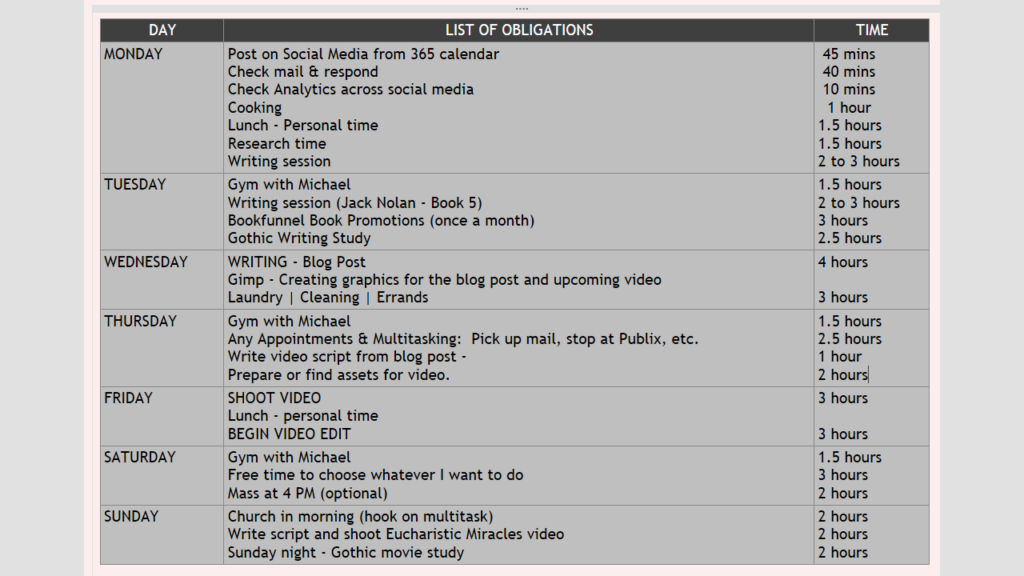 In the last installment, I described how to start your duties and obligations list with realistic times associated with each one. The list will prove itself over a week or so. Then you will be ready to expand on that list and make a series of workflows, templates, and procedure lists or diagrams. I have posted my own above to jog your memory as to where we left off.
In the last installment, I described how to start your duties and obligations list with realistic times associated with each one. The list will prove itself over a week or so. Then you will be ready to expand on that list and make a series of workflows, templates, and procedure lists or diagrams. I have posted my own above to jog your memory as to where we left off.
HOW TO RECLAIM TIME:
First let’s talk about strategies for finding, making and clawing back time from your days that may be wasted right now.
- Looking at your list, are there any obligations that you can take care of while waiting for other things in your life? For example: Can you make some calls as you wait in line to pick up kids at school?
- Can you save yourself a trip out of the house by hooking two or three errands together on the same day?
- If you are spending your lunch breaks listening to coworkers blathering on and on about inane things, can you write during your lunch hour? Or can you run an errand to clear a Saturday for a greater goal?
- Can you listen to an instructional video while driving home from work or some other obligation to make better use of time in traffic?
- Go through the list and see how you can mop up wasted time out of your days and reclaim that time for more or better things.
- If you have 10 minutes here and 20 minutes there, don’t waste it. Clean out your purse with the 10 minute time slot. Do online research for that 20 minutes.
Every minute that you make better use of will free your schedule for the higher goals you want to pursue. Will your life suffer if you miss out on office gossip at lunchtime? I doubt it.
A SPECIAL NOTE ABOUT GETTING LOST IN SOCIAL MEDIA:
Social media can be wonderful or it can be a time-wasting trap like none other. Be particularly careful with short videos or reels. This can be mindless and mind-numbing. One short video can lead to the next almost without willing it. We’ve all been there. Think of the times the internet, in whatever form, has stolen an entire morning or afternoon. In order to reach higher levels of accomplishment, this has to stop.
Assign yourself some mind-numbing social media time at night. You will have already met your daily accomplishment goals. By checking social media in the evenings, the news of the day has had time to ferment. You’ll be reading news instead of ‘breaking gossip’ or hours of speculation. You can see what your favorite social media people have said all day instead of in the last hour.
If you must go on social media during the day, set an alarm to sound in fifteen minutes. Then get back into accomplishment mode.
START THE WORK FLOW FROM THE TOP:
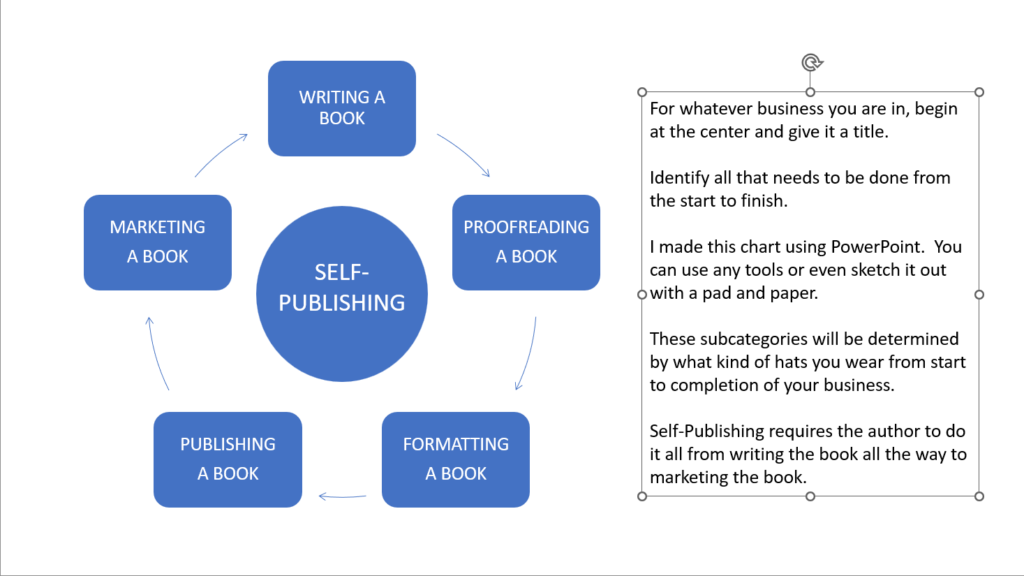
As a self-publisher, all of the hats I wear in writing and publishing books are noted in the chart above. Analyze and translate your business and make a similar chart. As we move along, we’ll drill down into each section and make work-flow diagrams, procedural lists, or informational sheets for just about everything that has to be done.
EVERY BUSINESS OR WORKFLOW NEEDS A FILING SYSTEM:
As you begin, it’s important to know how you will organize and file the work product you are about to produce. For example: How will you file your book manuscripts so you can put your fingers on them in two seconds? How will you file all the marketing graphics you produce once you create a social media presence? How will you file and store video files that may be too big to store on a laptop or a desktop?
It’s a good idea to think about this in your analyzing phase. Below, I’ll go into details about how I set up my book files to keep everything orderly and consistent.
STARTING AT THE TOP OF THE HIERARCHY:
Below is a snapshot of the top layer of my Self-Publishing Business. Each area represents another hat I wear in publishing my novels — or any other books I may decide to publish. I created this mindmap on a free tool called Freemind. What I like about this mindmapping software is that I can close each of the sections and only focus on what I need depending upon which segment of the self-publishing process I am in.
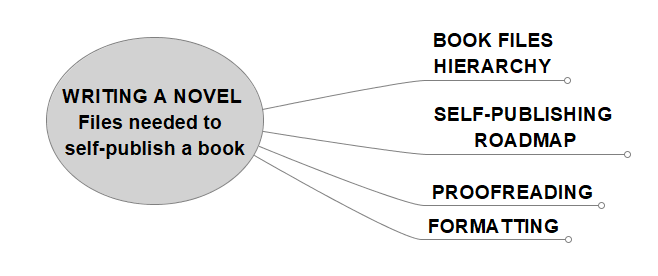
ORGANIZING MY BOOK FILES | MANUSCRIPTS & COVERS:
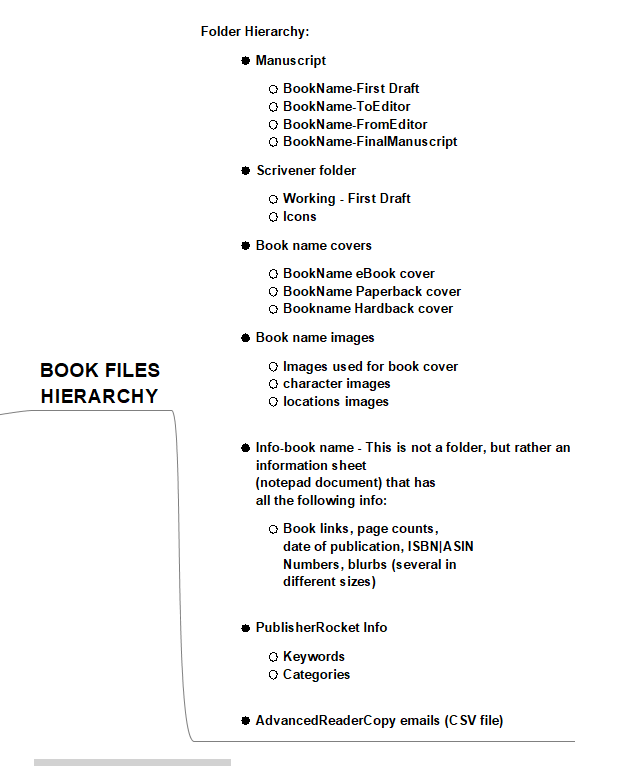
Above is the Book Files Hierarchy opened. It contains a list of all of the folders, sub-folders and files I need for each of my books. By having this visual, I can be consistent in the names of the folders, It’s even possible to set up the folders before you even finish a first draft.
When I wrote my first novel, I can’t tell you how many “drafts” I had and how mixed up I got with it all. This system makes everything clear and self-explanatory.
SELF-PUBLISHING ROADMAP:
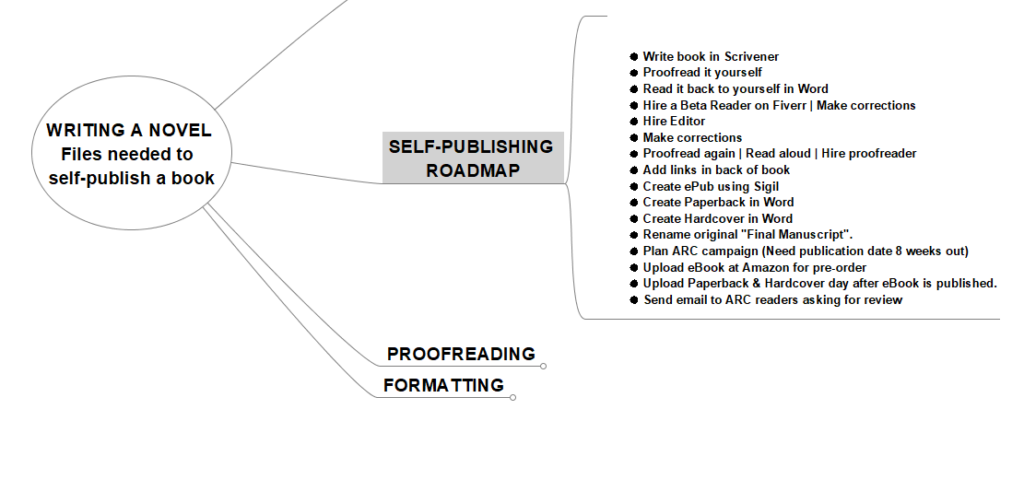
Above is the Self-Publishing Roadmap section opened. This is more of a chronological list of everything that has to be done. I have Procedural Lists and/or Informational Sheets with more detailed instructions for each of these steps. It seems a bit excessive, right? Not really. By using organizational tools, diagrams, and lists, it prevents me from having to reinvent the wheel each time I have to do something. I also don’t have to use valuable mental energy ‘figuring things out’.
There are many things I do on autopilot and I don’t use a list for those things. Anything I do everyday or once a week, I don’t need a list for. The lists come in handy when I’m doing something I only do occasionally. I believe by having these lists, I cut through any confusion or a bad memory. I have more energy to write!
LET’S LOOK AT THE PROOFREADING LIST:
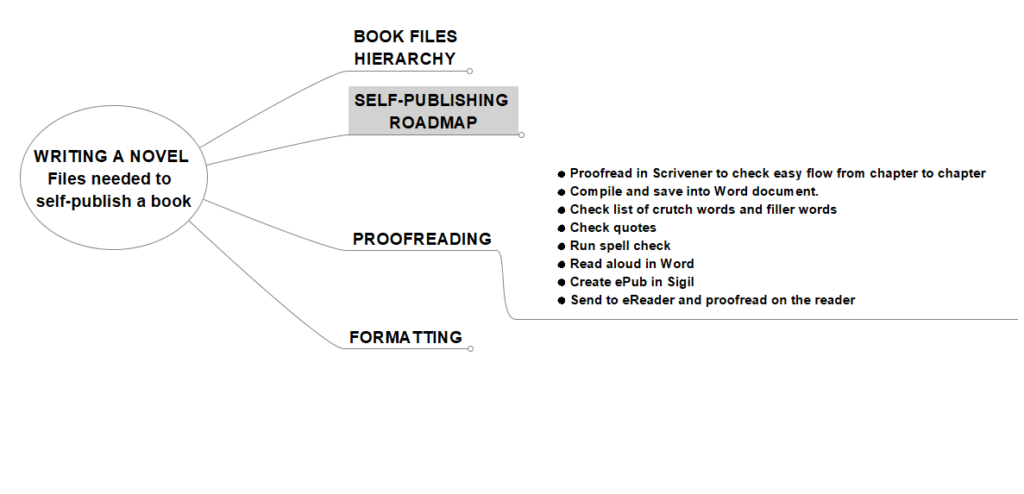
Above is a snapshot of the Proofreading tab opened. It has a chronological list of how I proofread. I proofread in layers because it makes it easier and less taxing.
LET’S OPEN THE FORMATTING TAB:
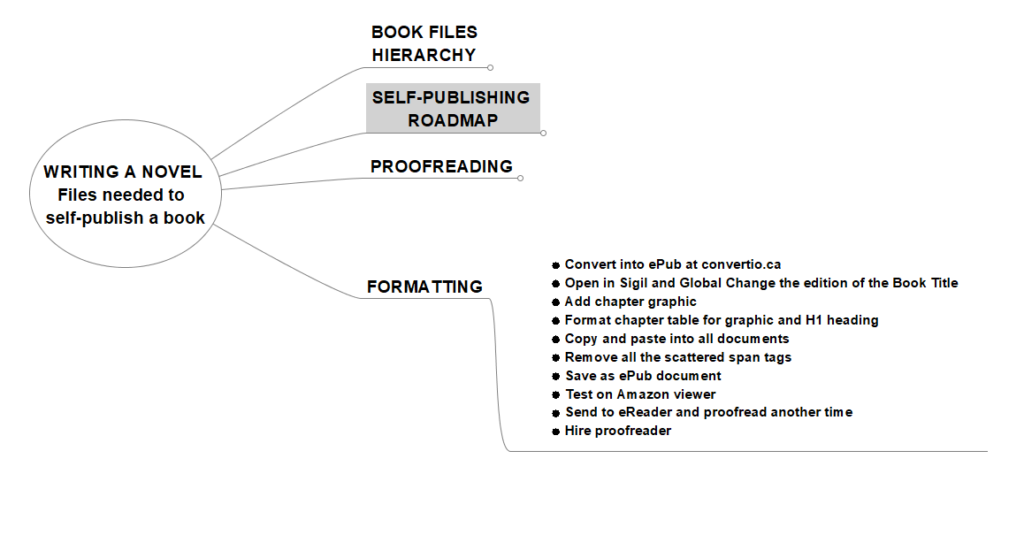
Above is the Formatting Tab opened up. It too has a chronological list of how I take my books from formatting the eBook, making the ePub for best upload on Amazon, to the paperback and Hardcover.
If ever I’m at a loss as to what comes next, no matter where I am in the self-publishing process, I just have to go to my list, and the next step will become as clear as day.
Below I have a short snippet where I open all of the sub categories and you can see the chronological lists that serve as guides and reminders of what every facet of the process requires.
INFORMATIONAL SHEETS | PROCEDURE LISTS | DIAGRAMS:
In creating workflow information for the entire self-publishing process, I use a series of Informational Sheets, Procedure Lists, and Diagrams. They all serve the same purpose: To make sure I know what is needed, it functions as a memory jogger, and gives me a sense of knowing I’m not forgetting anything.
Below is a Video Snippet showing one my Informational Sheet on Formatting. I have been adding information and specific notes about experiences I’ve had with formatting for the last several years. I check this list before beginning any formatting so I refresh my memory about any little snags that happened in the past. This is a great time saver.
Below is a video snippet scrolling through the Formatting Info Sheet.
In the next installment, I will cover my Blog and Video Procedural List. This allows me to easily write a blog, convert it to a video script, and make blog graphics and video overlay panels at the same time. Multitasking supercharged! See you in the next installment!

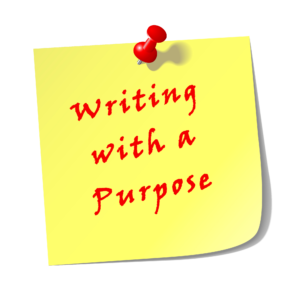 veryone writes for a reason. Knowing why you write is important, especially as a beginner writer. Writing a book is not hard, but it can be a long process. If your purpose for writing is clear, this will give you the energy and inspiration to spur you on if and/or when the going gets a little tough.
veryone writes for a reason. Knowing why you write is important, especially as a beginner writer. Writing a book is not hard, but it can be a long process. If your purpose for writing is clear, this will give you the energy and inspiration to spur you on if and/or when the going gets a little tough.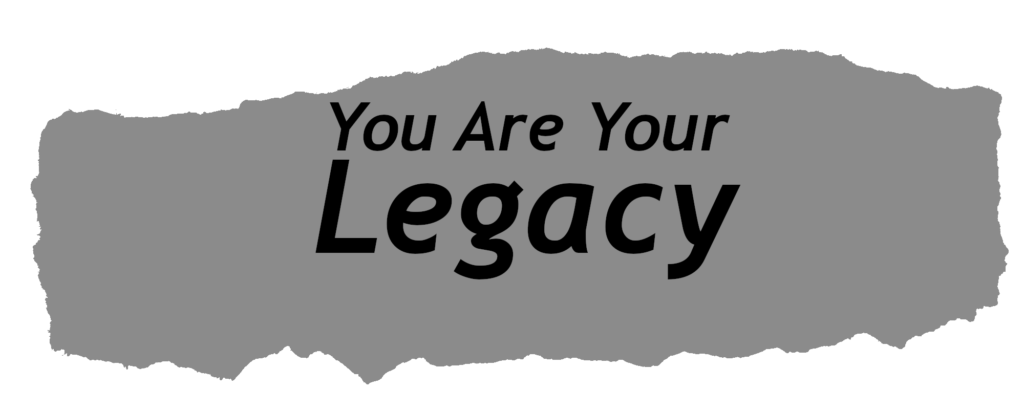
 I’m old enough to remember ‘phone guys’ that worked for Bell South or whatever the phone company was called back then. These men — they didn’t have phone women back then — would show up with big toolbelts and gaffs or lineworker boots on. These boots had cleats or little metal spikes in them that was a safety feature. These men know everything about the phone system. They would climb the wooden telephone poles and they could fix phones outside on the pole or inside in the houses. They were familiar with the entire system. That is one group of technical workers that have fallen away.
I’m old enough to remember ‘phone guys’ that worked for Bell South or whatever the phone company was called back then. These men — they didn’t have phone women back then — would show up with big toolbelts and gaffs or lineworker boots on. These boots had cleats or little metal spikes in them that was a safety feature. These men know everything about the phone system. They would climb the wooden telephone poles and they could fix phones outside on the pole or inside in the houses. They were familiar with the entire system. That is one group of technical workers that have fallen away. Very often life dishes out some hard times to some of us. Did you experience, survive and prosper through some difficult times that you feel compelled to write a memoir about? You don’t have to have been a famous celebrity or someone with a Moses-like mission. You may have fell on hard times and you want to share your experience, strength or faith that kept you going. People love inspirational stories.
Very often life dishes out some hard times to some of us. Did you experience, survive and prosper through some difficult times that you feel compelled to write a memoir about? You don’t have to have been a famous celebrity or someone with a Moses-like mission. You may have fell on hard times and you want to share your experience, strength or faith that kept you going. People love inspirational stories.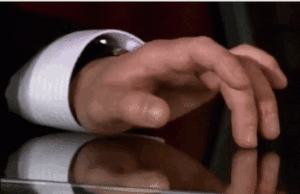 When I self-published my first novel, I finished it and uploaded it and waited. That’s when I learned how important marketing the book is. I also learned through the next several books how important it is to take advantage of each tiny phase of a book launch for marketing. That’s what this blog post is about.
When I self-published my first novel, I finished it and uploaded it and waited. That’s when I learned how important marketing the book is. I also learned through the next several books how important it is to take advantage of each tiny phase of a book launch for marketing. That’s what this blog post is about. A gun silencer, also known as a suppressor, is a muzzle device that reduces the sound of a gunshot. It does this by slowing down and cooling the expanding gases that are released from the barrel when the gun is fired. Silencers do not completely silence a gunshot, but they can reduce the sound level by 20 to 30 decibels. This can make a significant difference in the loudness of the gunshot, making it much less noticeable to people nearby.
A gun silencer, also known as a suppressor, is a muzzle device that reduces the sound of a gunshot. It does this by slowing down and cooling the expanding gases that are released from the barrel when the gun is fired. Silencers do not completely silence a gunshot, but they can reduce the sound level by 20 to 30 decibels. This can make a significant difference in the loudness of the gunshot, making it much less noticeable to people nearby. A ballistic report is a record of the characteristics of a bullet, such as its caliber, weight, and velocity. Ballistic reports are used by law enforcement to identify the type of gun that was used in a crime. They can also be used to determine the range from which a shot was fired.
A ballistic report is a record of the characteristics of a bullet, such as its caliber, weight, and velocity. Ballistic reports are used by law enforcement to identify the type of gun that was used in a crime. They can also be used to determine the range from which a shot was fired.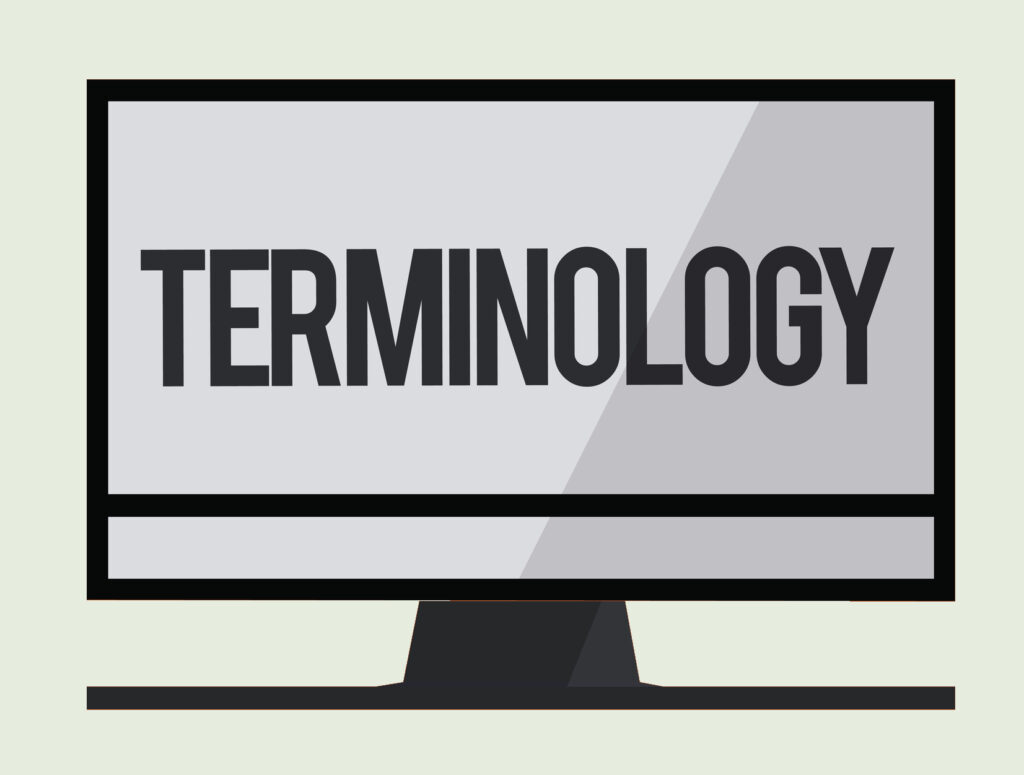 Here are some of the terms that are commonly used in the field of gun silencers and ballistics:
Here are some of the terms that are commonly used in the field of gun silencers and ballistics: A silencer can leave markings on a bullet. These markings are called “tool marks” and they are caused by the rough interior surface of the silencer rubbing against the bullet as it passes through. The tool marks can be microscopic or macroscopic, depending on the type of silencer and the type of bullet.
A silencer can leave markings on a bullet. These markings are called “tool marks” and they are caused by the rough interior surface of the silencer rubbing against the bullet as it passes through. The tool marks can be microscopic or macroscopic, depending on the type of silencer and the type of bullet. Ballistics experts can use these tool marks to identify the silencer that was used in a shooting. They can also use the tool marks to determine the distance from which the shot was fired.
Ballistics experts can use these tool marks to identify the silencer that was used in a shooting. They can also use the tool marks to determine the distance from which the shot was fired.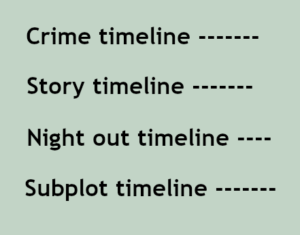 Although I follow a detailed outline of the story before I even start writing, each novel presents its own issues and/or problems. In this novel, I had several timelines I had to keep straight.
Although I follow a detailed outline of the story before I even start writing, each novel presents its own issues and/or problems. In this novel, I had several timelines I had to keep straight.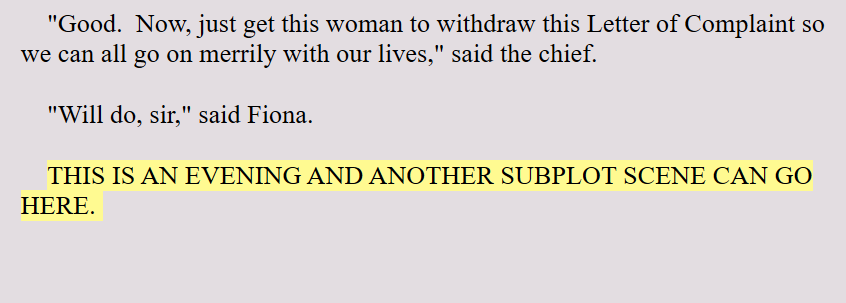
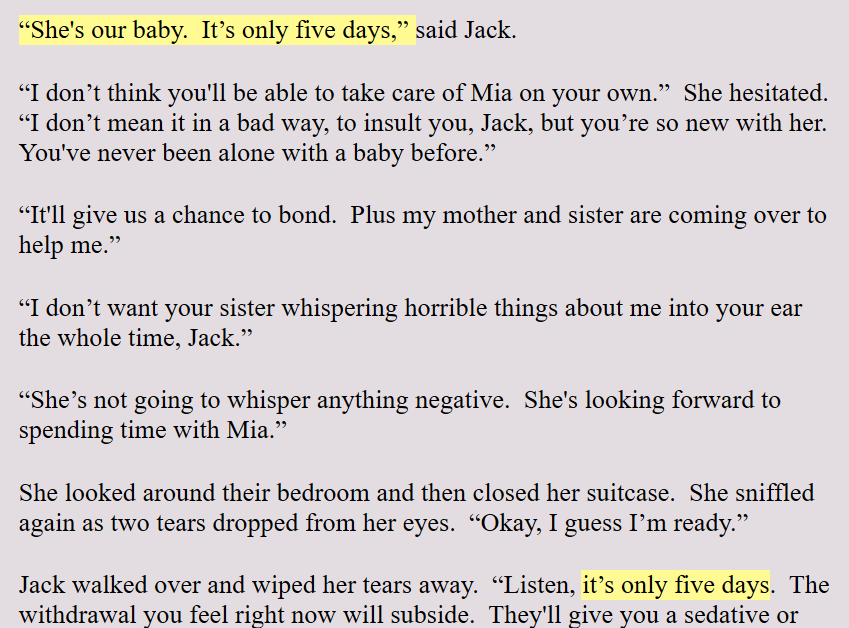
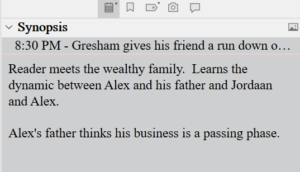 The second thing I do in Layer 5 is to fill out the Synopsis section. This section is in the upper right-hand side of the Scrivener platform.
The second thing I do in Layer 5 is to fill out the Synopsis section. This section is in the upper right-hand side of the Scrivener platform.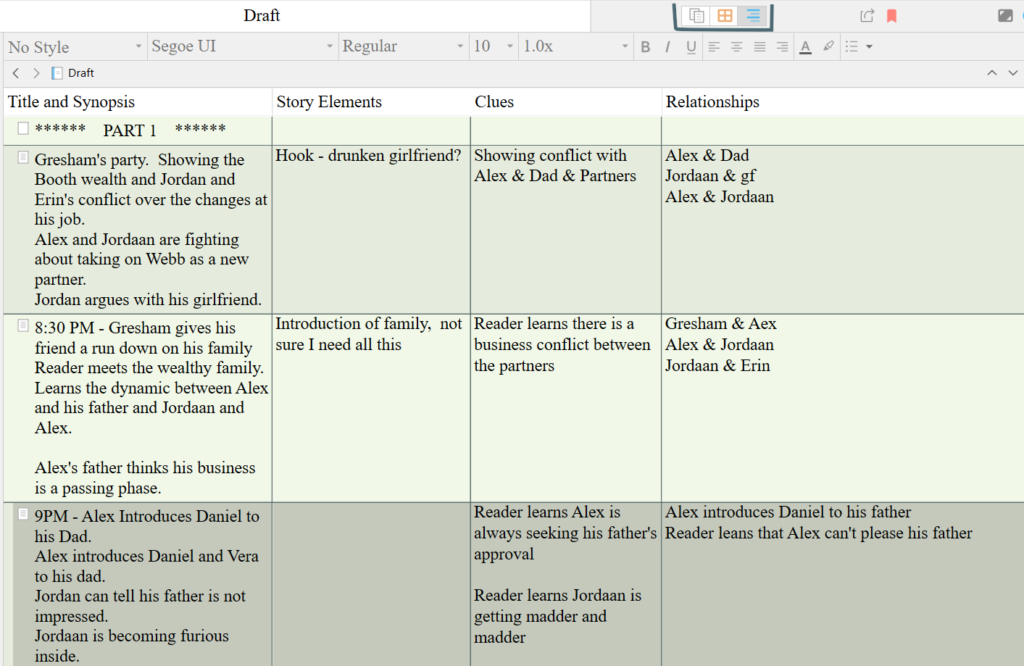
 Turn these Scrivener features off, especially if you plan to move your finished novel draft into Microsoft Word for final formatting. Because I self-publish and I need to upload in ePub and PDF manuscript, I use Word for a final proofread and formatting. I find Word is the best choice for me. The smart quotes do not translate well between Scrivener and Word. If you turn off the smart quotes, Scrivener will replace them with straight quotes and these translate better.
Turn these Scrivener features off, especially if you plan to move your finished novel draft into Microsoft Word for final formatting. Because I self-publish and I need to upload in ePub and PDF manuscript, I use Word for a final proofread and formatting. I find Word is the best choice for me. The smart quotes do not translate well between Scrivener and Word. If you turn off the smart quotes, Scrivener will replace them with straight quotes and these translate better. I’m writing my fourth novel in the Jack Nolan Detective Series. The book is still unnamed. This is Level 4 in my Eight Levels of Writing a Novel series. This first draft is down and dirty. It is the hardest lift of the entire project. At least for me, the first draft is the hardest. The characters all seem like stick figures. I find them unlikeable — even if I liked them in the last book! Any humor doesn’t seem to work. Everything just seems awkward. I have to literally force myself to keep typing. So this tip is to just keep writing. Don’t check on any spellings or grammar. Don’t even look back. Just keep going until you have the crime down, the main plotline down and the subplots at least in place. That will complete the first down-and-dirty draft. Every other layer will be easy compared to this one.
I’m writing my fourth novel in the Jack Nolan Detective Series. The book is still unnamed. This is Level 4 in my Eight Levels of Writing a Novel series. This first draft is down and dirty. It is the hardest lift of the entire project. At least for me, the first draft is the hardest. The characters all seem like stick figures. I find them unlikeable — even if I liked them in the last book! Any humor doesn’t seem to work. Everything just seems awkward. I have to literally force myself to keep typing. So this tip is to just keep writing. Don’t check on any spellings or grammar. Don’t even look back. Just keep going until you have the crime down, the main plotline down and the subplots at least in place. That will complete the first down-and-dirty draft. Every other layer will be easy compared to this one. Scrivener allows you to highlight text in any color you want. I use this highlighter in the Level 4 Draft to make a mental note to myself to check on things. For example: If I say that someone is coming home from a hospital in four days, I highlight this. This makes sure that this lines up with the plotline, or the crime line, or the subplot lines.
Scrivener allows you to highlight text in any color you want. I use this highlighter in the Level 4 Draft to make a mental note to myself to check on things. For example: If I say that someone is coming home from a hospital in four days, I highlight this. This makes sure that this lines up with the plotline, or the crime line, or the subplot lines.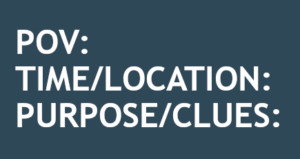 Like I mentioned earlier, I’m in the first draft of my novel and each scene begins with the same Scene Template as seen to the left.
Like I mentioned earlier, I’m in the first draft of my novel and each scene begins with the same Scene Template as seen to the left.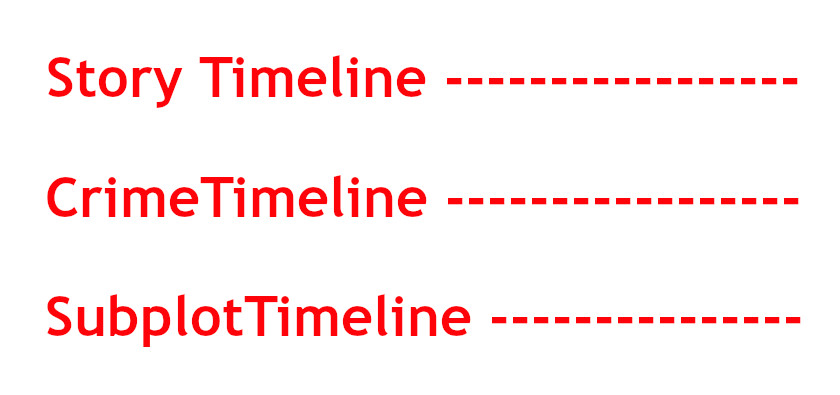
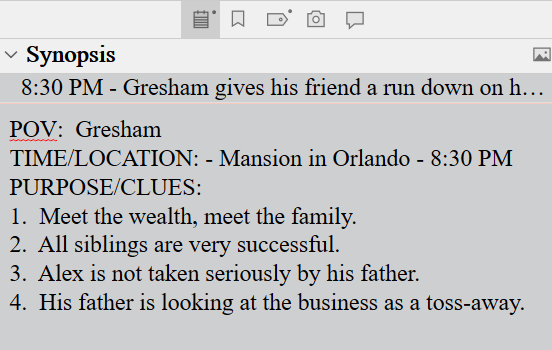 When writing the first draft, I use the Scrivener Synopsis section in the Inspector Pane to list the clues I have dropped in that scene. Once I’ve finished the first draft, I can open the project in Outline View and this will give me a bird’s eye view and chronology of the clues that have been dropped.
When writing the first draft, I use the Scrivener Synopsis section in the Inspector Pane to list the clues I have dropped in that scene. Once I’ve finished the first draft, I can open the project in Outline View and this will give me a bird’s eye view and chronology of the clues that have been dropped.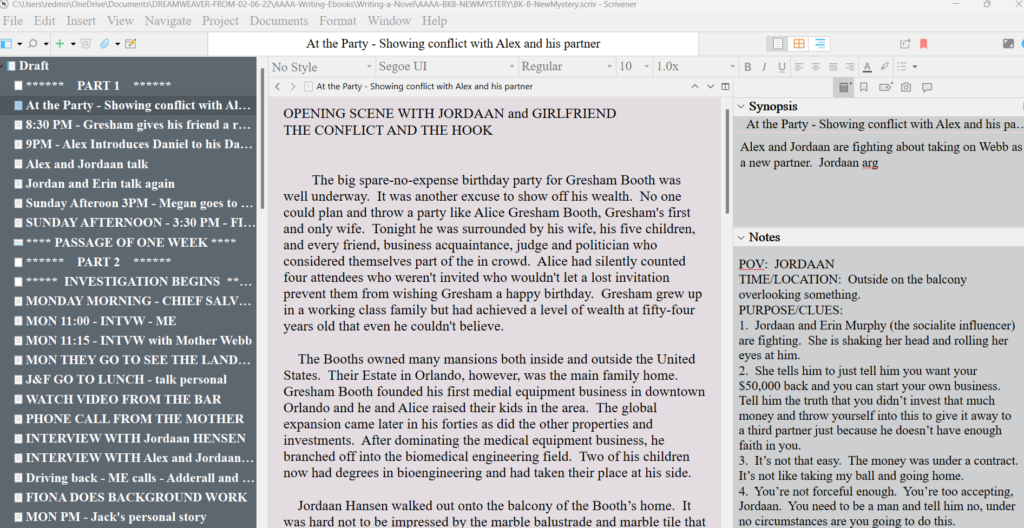 I am knee-deep in Level 4 of writing the next book in the Jack Nolan Detective Series. I thought this would be a good time for me to take a break and reflect on what happens when I’m ‘in the weeds’ writing a novel.
I am knee-deep in Level 4 of writing the next book in the Jack Nolan Detective Series. I thought this would be a good time for me to take a break and reflect on what happens when I’m ‘in the weeds’ writing a novel. When you first sit down to write a novel, everyone is filled with enthusiasm and creative energy. It’s exciting. It’s new. But as the manuscript begins to grow, before it feels finished — or even ready to be polished, it feels cumbersome, heavy, and overwhelming. At least for me it does.
When you first sit down to write a novel, everyone is filled with enthusiasm and creative energy. It’s exciting. It’s new. But as the manuscript begins to grow, before it feels finished — or even ready to be polished, it feels cumbersome, heavy, and overwhelming. At least for me it does. Writers block is another common problem among authors. This often sets in after that initial period of excitement about the novel wears off. At some point the writing of the novel shifts into a project requiring some heavy lifting. There’s always a phase or two where the author has to tough it out. We have to keep at it.
Writers block is another common problem among authors. This often sets in after that initial period of excitement about the novel wears off. At some point the writing of the novel shifts into a project requiring some heavy lifting. There’s always a phase or two where the author has to tough it out. We have to keep at it.
 Will my readers like the book? Will the book be good enough to get a literary agent? What happens if my book gets bad reviews? There are any number of fears of rejection that can cause us to stop writing. Decide ahead of time you won’t allow these fears to stop you. Like I said earlier, think of your writing as a mission God has given you. This is your life’s work, along with your other worldly responsibilities. Your writing could be an opportunity to pass on things you have come to learn in your life. That’s a purpose. Or maybe writing is a way for you to share the gift of storytelling that you know you were born with. That’s a God-given purpose. Whatever the reason, it’s important to not allow fear of rejection to get in the way.
Will my readers like the book? Will the book be good enough to get a literary agent? What happens if my book gets bad reviews? There are any number of fears of rejection that can cause us to stop writing. Decide ahead of time you won’t allow these fears to stop you. Like I said earlier, think of your writing as a mission God has given you. This is your life’s work, along with your other worldly responsibilities. Your writing could be an opportunity to pass on things you have come to learn in your life. That’s a purpose. Or maybe writing is a way for you to share the gift of storytelling that you know you were born with. That’s a God-given purpose. Whatever the reason, it’s important to not allow fear of rejection to get in the way. Distractions are one of the biggest obstacles to completing a novel. One reason is because life does serve up constant small and big emergencies that have to take first priorities in our lives. So an emergency distraction can throw a whole well-planned writing schedule up into the air in a heartbeat.
Distractions are one of the biggest obstacles to completing a novel. One reason is because life does serve up constant small and big emergencies that have to take first priorities in our lives. So an emergency distraction can throw a whole well-planned writing schedule up into the air in a heartbeat. Most novels require at least some research. The internet can be a blessing with research but it can also be a curse. It’s a blessing because the days of having to travel to a public library are over. It can be a curse because the research can suck you in and you can use up all your valuable writing time doing too much research.
Most novels require at least some research. The internet can be a blessing with research but it can also be a curse. It’s a blessing because the days of having to travel to a public library are over. It can be a curse because the research can suck you in and you can use up all your valuable writing time doing too much research. Another trap to finishing a novel is to get caught up in a never-ending edit of the book. This usually hooks in with perfectionism problem in some way.
Another trap to finishing a novel is to get caught up in a never-ending edit of the book. This usually hooks in with perfectionism problem in some way.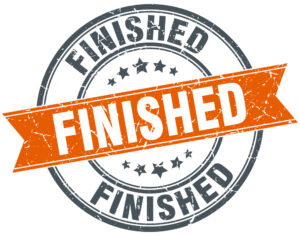 Once you complete a novel, there is a little sadness that sets in. This book is no longer your baby. It’s no longer your little pet project. Once you hand it off to an editor, it becomes a shared work, so to speak.
Once you complete a novel, there is a little sadness that sets in. This book is no longer your baby. It’s no longer your little pet project. Once you hand it off to an editor, it becomes a shared work, so to speak. I’m assuming all writers have doubts as they are writing the first draft. I know I do. Something happens between the feeling of knowing I have a good plotline and writing out the first draft.
I’m assuming all writers have doubts as they are writing the first draft. I know I do. Something happens between the feeling of knowing I have a good plotline and writing out the first draft. So the antidote to self-doubt is to keep writing. Trust your plotline. Know too that you can always add clues, rearrange some scenes, add a bit more intrigue into your subplots. Eight layers of writing leaves a lot of room for beefing up a story, deepening a story and polishing a story.
So the antidote to self-doubt is to keep writing. Trust your plotline. Know too that you can always add clues, rearrange some scenes, add a bit more intrigue into your subplots. Eight layers of writing leaves a lot of room for beefing up a story, deepening a story and polishing a story.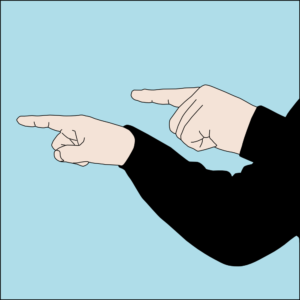 Most new writers want to get to the writing already. But in this layer of writing, all plot holes or inconsistencies will show up. Any clues that won’t work when adding more suspects and motivations will show up in this layer.
Most new writers want to get to the writing already. But in this layer of writing, all plot holes or inconsistencies will show up. Any clues that won’t work when adding more suspects and motivations will show up in this layer. n order to prevent head-hopping, which is very common among new writers, you need to be constantly reminded that each scene is in one perspective. Some writers write in first person and that’s easy.
n order to prevent head-hopping, which is very common among new writers, you need to be constantly reminded that each scene is in one perspective. Some writers write in first person and that’s easy.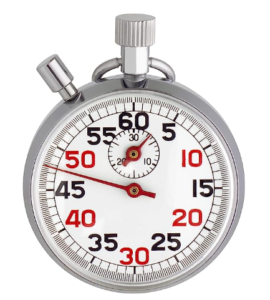 I don’t know whether I am an author who is obsessed with time, or whether I use time as an element to put pressure to solve on my characters, but I have always tracked time. I find this helps me balance the story and make the story more realistic.
I don’t know whether I am an author who is obsessed with time, or whether I use time as an element to put pressure to solve on my characters, but I have always tracked time. I find this helps me balance the story and make the story more realistic. Location is important for two reasons. One reason is casts the scene in cement. You have chosen a stage for the scene to take place. I don’t write any scene or location descriptions in this layer of writing. But I can write the action of the scene in context of a location.
Location is important for two reasons. One reason is casts the scene in cement. You have chosen a stage for the scene to take place. I don’t write any scene or location descriptions in this layer of writing. But I can write the action of the scene in context of a location.
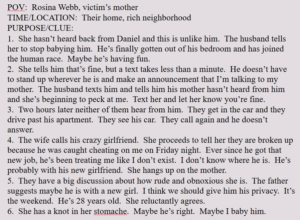
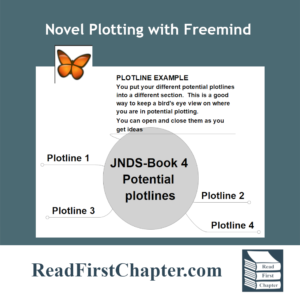 In the first installment of the Peek Behind the Novel Series, I wrote about working four different plotlines before choosing one. By working on four of them, it helps me ‘improve’ on some storylines and when I have four to choose from, I am able to go into the project knowing that I have chosen the best one. It’s a technique that I use to build my author confidence.
In the first installment of the Peek Behind the Novel Series, I wrote about working four different plotlines before choosing one. By working on four of them, it helps me ‘improve’ on some storylines and when I have four to choose from, I am able to go into the project knowing that I have chosen the best one. It’s a technique that I use to build my author confidence.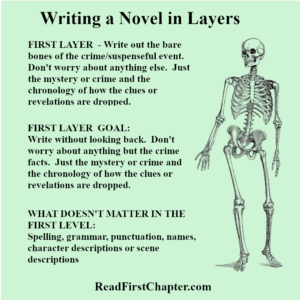 In the first layer of writing, I focus only on the crime or mystery. I make a list of the chronology of the crime. How it happens, who it happens to, how the detectives are assigned to the case. I focus only on the crime. I don’t think of subplots, or dialogue or even the outcome. Only on the crime itself, almost like a Forensic Files show.
In the first layer of writing, I focus only on the crime or mystery. I make a list of the chronology of the crime. How it happens, who it happens to, how the detectives are assigned to the case. I focus only on the crime. I don’t think of subplots, or dialogue or even the outcome. Only on the crime itself, almost like a Forensic Files show.